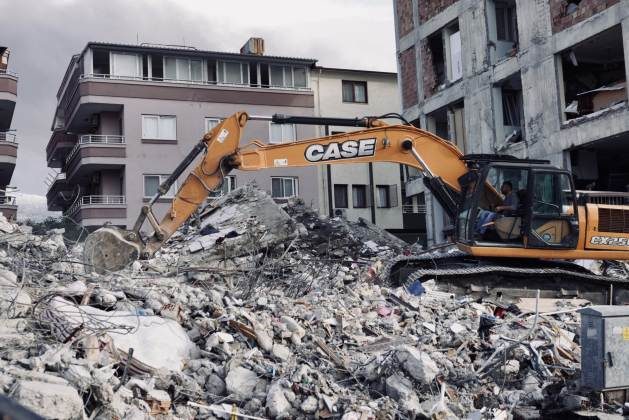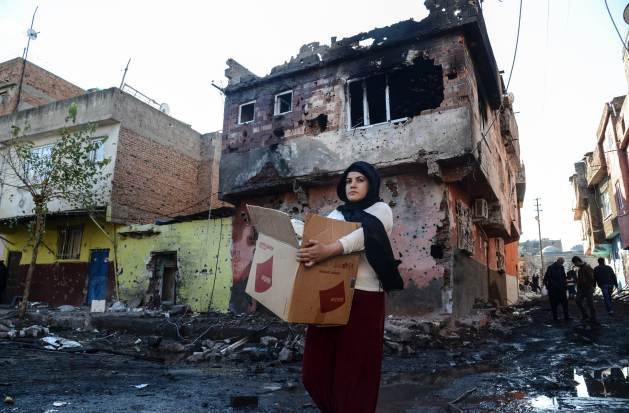Turkey's Shaky Foundations

ROME, Feb 14 (IPS) - Geology explains the terrible earthquake that shook Turkey and Syria on February 6 with academic coldness: the Arabian, Eurasian and African plates pressure the Anatolian plate. On the surface, geopolitics resorts to concepts like "fault", "tension" or "fracture" to explain things too. When one looks at Turkey, both disciplines’ maps can easily overlap each other, with a death toll calculated in the tens of thousands.
The earthquake’s epicentre lies in a chasm that has been widening since World War I (1914-1918), when the Kurdish people were left stateless. Over 40 million Kurds remain spread across the borders of Iran, Turkey, Syria and Iraq.
Half of them live in the southeastern region of Turkey. It is not by chance that the broken North-South socioeconomic divide in Anatolia actually shows itself from west to east.
Tour operators offer two main tourist packages: touring the west of the country in clockwise or anti-clockwise directions.
The east is never an option, even if you miss the astonishing Neolithic archaeological site of Gobekli, or the source of the Tigris and Euphrates, among other treasures.
Actually, "Kurdistan" has always been a taboo word for the Turkish national narrative, which favours euphemisms such as "the southeast" to refer to that part of the country. After all, what name can be given to what doesn't even exist?
For decades there was no talk of Kurds, but of "mountain Turks." Their language, Kurmanji, still has not reached newspapers or schools. There is indeed a television channel in Kurdish - there are around fifty in neighbouring Iraq - but it is government funded. Accordingly, there´s no deviation from the official discourse.
Without leaving the epicentre of the earthquake, the city of Kahramanmaras owes its name to the Turkification of its original Maras (of disputed origin) to which is added the Turkish Kahraman, "hero". Also, better not look for "Amed" on maps when trying to get to Diyarbakir, Turkey's main Kurdish city.
These are just two of the thousands of examples that speak of this drive to erase all “foreign” traces from the maps. The next step is to do it physically. The city of Hasankeyf, a 12,000-year-old archaeological treasure once protected by UNESCO, was completely flooded in 2020.

Today, Hasankey lies out of reach under a network of dams through which the water supply from the Tigris and the Eufrates to Syria and Iraq is often cut off.
The most modern cities are not spared either. In the 1980s and 1990s, thousands of Kurdish towns were burned down by the Turkish Army in the war against the Kurdish guerrillas of the Kurdistan Workers' Party (PKK).
In the wake of the umpteenth military operation launched by Ankara in 2015 and 2016, the rubble in several of them was reminiscent of that of the last earthquake. Once again, the civilians then took the worst part.
"You are not Kurdish, you are Armenian and we are going to do the same we did to you a hundred years ago," this reporter heard a Turkish police officer shout over a loudspeaker during the curfew enforced on the Kurdish city of Cizre, in September 2015.
Two earthquakes (in 1912 and 1914) announced what was to become the first genocide of the 20th century, when more than a million and a half Armenians were swallowed by that same fault.
Today, in Turkey there are barely 60,000 castaways from that Eurasian plate, and the waves are still hitting neighbouring Armenia, which remains sandwiched between two Turkic states (the second one is Azerbaijan).
"How happy is the one who says I am a Turk," read murals across Turkey, paraphrasing Kemal Ataturk, the controversial father of the republic. "The homeland is indivisible" is also a recurrent one.
The cruelest paradox decrees that the country celebrates its first hundred years of existence slit open. Turkish President Recep Tayip Erdo?an has already declared a state of emergency for three months in ten devastated regions.
The complaints that relief does not arrive pile up, creating an even more precarious situation for over three million Syrian refugees who´ve crossed the border to Turkey since the war started in Syria in 2011.
The earth has burst under their feet after more than a decade since the war broke out in his country. They are the most direct victims of the Arabian plate, the one governed by autocrats such as Bashar al Assad in Syria, General Abdulfatah al Sissi in Egypt or the satraps of the Persian Gulf.
They all share with Erdo?an an obsession with perpetuating themselves in power and an exclusive discourse on which to articulate their respective country models.
More paradoxes in history make Erdo?an come to power in the aftermath of the Izmir earthquake in 1999 -it left more than 17,000 deaths-, and the last one occurred on the eve of decisive elections next May.
But perhaps the deepest fault is that of democracy.
After more than two decades in power, Erdo?an had shielded his re-election by disqualifying Ekrem Imamoglu, the mayor of Istanbul and his most direct rival in the opposition Republican People's Party (CHP).
He had also outlawed the third political force, the pro-Kurdish Peoples' Democratic Party (HDP). Their leaders, Selahattin Demirtas and Figen Yüksekda?, have been in prison since 2016.
"If my mother tongue is shaking the foundations of your state, it probably means that you built your state on my land," said Musa Anter, a Kurdish journalist and writer assassinated by Turkish intelligence agents in 1992.
Add to that the brutal jolts of geology, and disaster is served.
© Inter Press Service (2023) — All Rights Reserved. Original source: Inter Press Service
 Global Issues
Global Issues